Value Investments Report: Analysis of Accounting Framework and Issues
VerifiedAdded on 2022/11/30
|6
|1100
|80
Report
AI Summary
This report delves into the analysis of value investments within the context of the revised (2018) conceptual framework for financial reporting, as finalized by the International Accounting Standards Board (IASB). The report addresses four key questions, each focusing on different aspects of the framework. The first question examines the conceptual framework's structure, objectives, advantages, and identified problems, particularly the definition of liability. The second question explores the primary objectives of general-purpose financial reporting, highlighting the importance of presenting relevant financial information and its link to the firm's operational decisions. The third question focuses on the concept of prudence in accounting, including asymmetric prudence and its implications for inventory valuation. The fourth question discusses the concept of substance over form and its application in accounting, along with the author's agreement with the board’s decision on faithful representation. The report provides a comprehensive analysis of the conceptual framework and its application in the context of value investments.
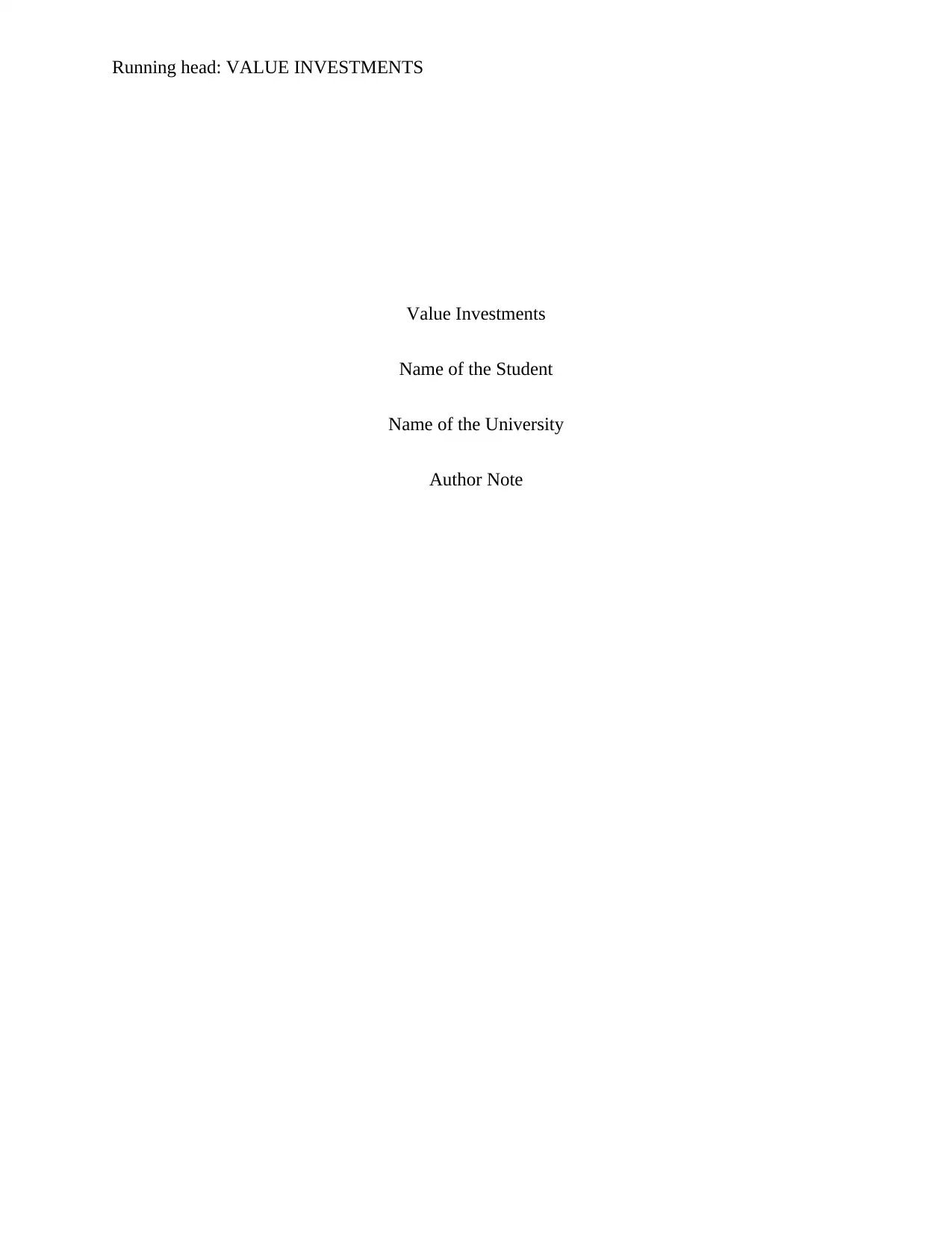
Running head: VALUE INVESTMENTS
Value Investments
Name of the Student
Name of the University
Author Note
Value Investments
Name of the Student
Name of the University
Author Note
Paraphrase This Document
Need a fresh take? Get an instant paraphrase of this document with our AI Paraphraser
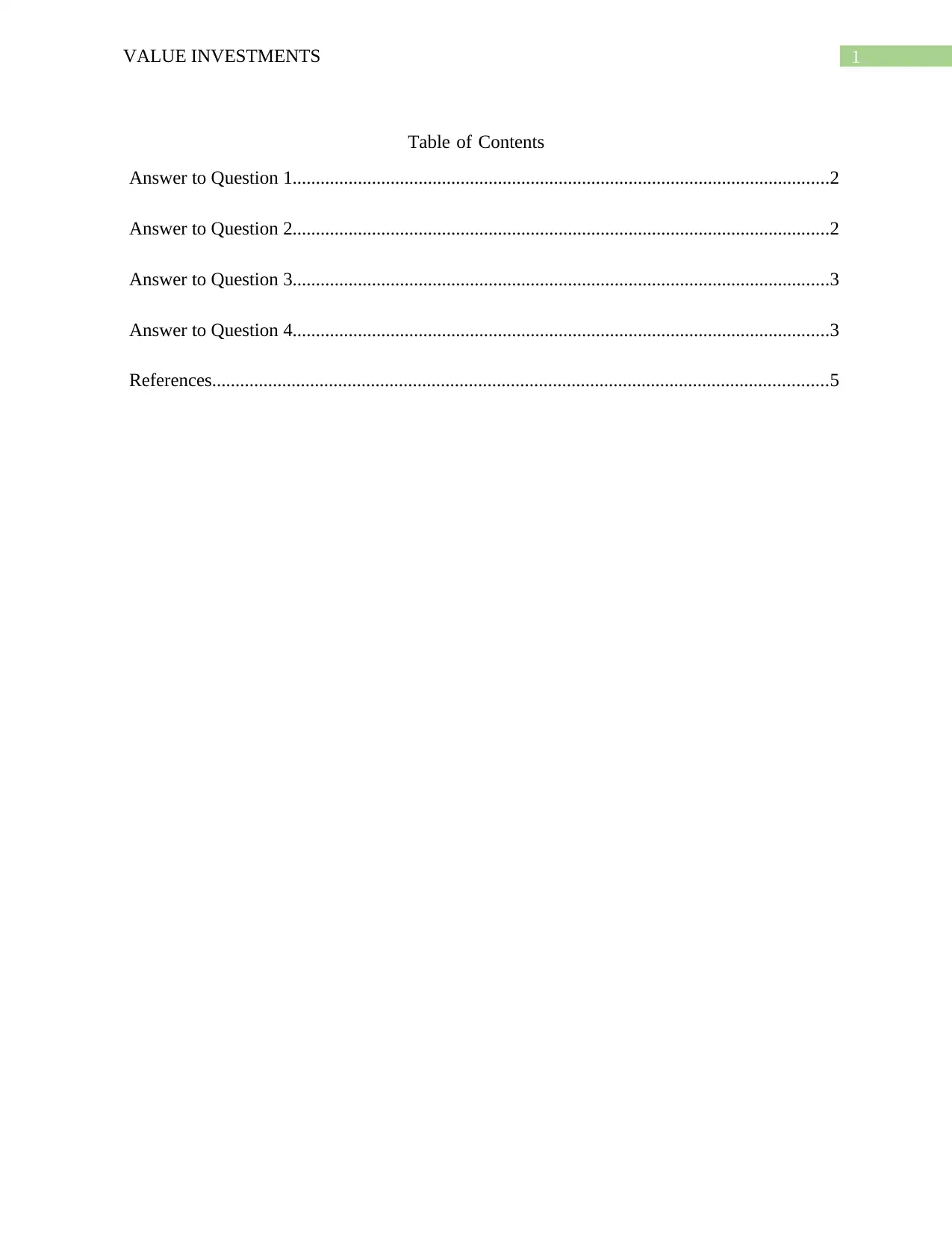
1VALUE INVESTMENTS
Table of Contents
Answer to Question 1...................................................................................................................2
Answer to Question 2...................................................................................................................2
Answer to Question 3...................................................................................................................3
Answer to Question 4...................................................................................................................3
References....................................................................................................................................5
Table of Contents
Answer to Question 1...................................................................................................................2
Answer to Question 2...................................................................................................................2
Answer to Question 3...................................................................................................................3
Answer to Question 4...................................................................................................................3
References....................................................................................................................................5
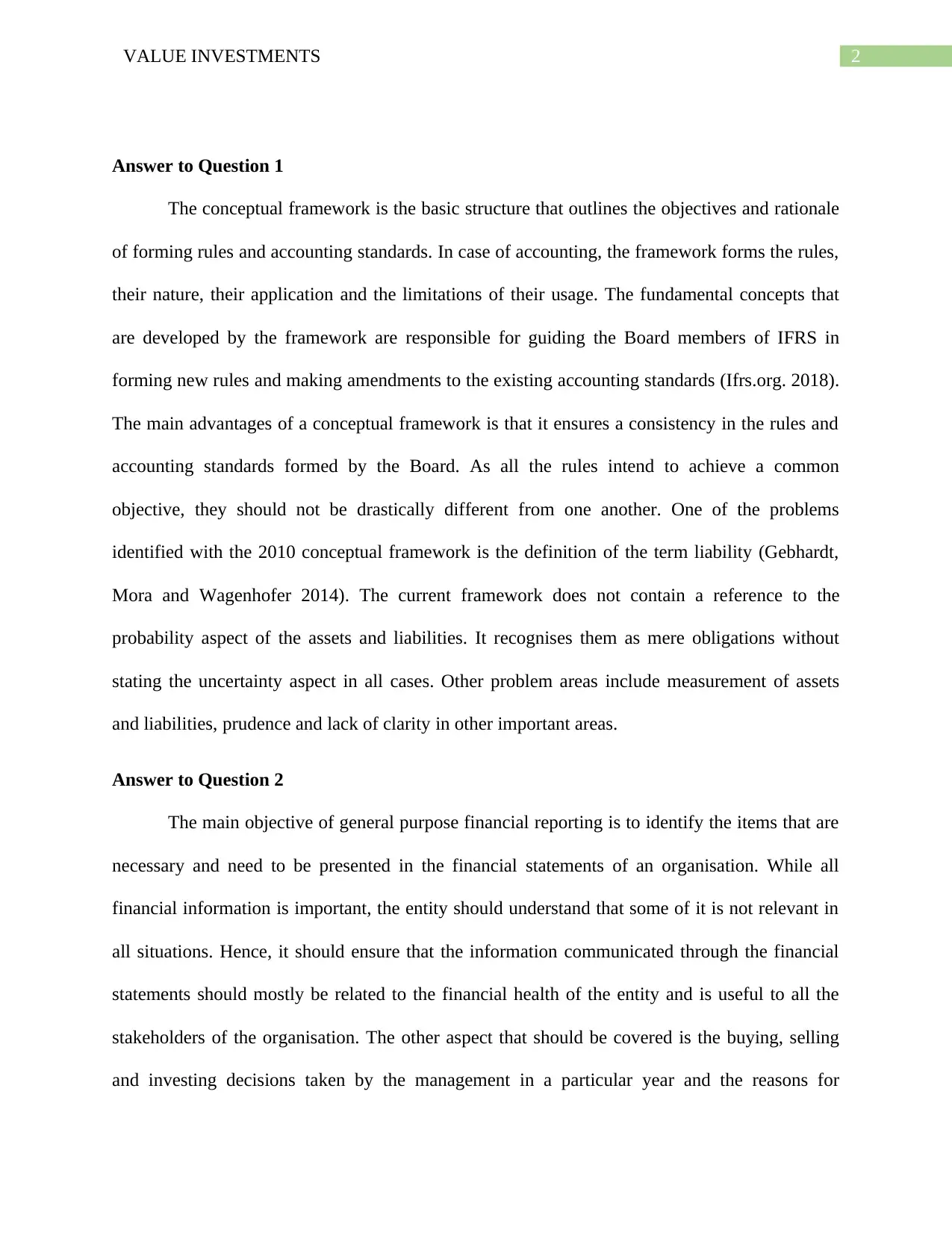
2VALUE INVESTMENTS
Answer to Question 1
The conceptual framework is the basic structure that outlines the objectives and rationale
of forming rules and accounting standards. In case of accounting, the framework forms the rules,
their nature, their application and the limitations of their usage. The fundamental concepts that
are developed by the framework are responsible for guiding the Board members of IFRS in
forming new rules and making amendments to the existing accounting standards (Ifrs.org. 2018).
The main advantages of a conceptual framework is that it ensures a consistency in the rules and
accounting standards formed by the Board. As all the rules intend to achieve a common
objective, they should not be drastically different from one another. One of the problems
identified with the 2010 conceptual framework is the definition of the term liability (Gebhardt,
Mora and Wagenhofer 2014). The current framework does not contain a reference to the
probability aspect of the assets and liabilities. It recognises them as mere obligations without
stating the uncertainty aspect in all cases. Other problem areas include measurement of assets
and liabilities, prudence and lack of clarity in other important areas.
Answer to Question 2
The main objective of general purpose financial reporting is to identify the items that are
necessary and need to be presented in the financial statements of an organisation. While all
financial information is important, the entity should understand that some of it is not relevant in
all situations. Hence, it should ensure that the information communicated through the financial
statements should mostly be related to the financial health of the entity and is useful to all the
stakeholders of the organisation. The other aspect that should be covered is the buying, selling
and investing decisions taken by the management in a particular year and the reasons for
Answer to Question 1
The conceptual framework is the basic structure that outlines the objectives and rationale
of forming rules and accounting standards. In case of accounting, the framework forms the rules,
their nature, their application and the limitations of their usage. The fundamental concepts that
are developed by the framework are responsible for guiding the Board members of IFRS in
forming new rules and making amendments to the existing accounting standards (Ifrs.org. 2018).
The main advantages of a conceptual framework is that it ensures a consistency in the rules and
accounting standards formed by the Board. As all the rules intend to achieve a common
objective, they should not be drastically different from one another. One of the problems
identified with the 2010 conceptual framework is the definition of the term liability (Gebhardt,
Mora and Wagenhofer 2014). The current framework does not contain a reference to the
probability aspect of the assets and liabilities. It recognises them as mere obligations without
stating the uncertainty aspect in all cases. Other problem areas include measurement of assets
and liabilities, prudence and lack of clarity in other important areas.
Answer to Question 2
The main objective of general purpose financial reporting is to identify the items that are
necessary and need to be presented in the financial statements of an organisation. While all
financial information is important, the entity should understand that some of it is not relevant in
all situations. Hence, it should ensure that the information communicated through the financial
statements should mostly be related to the financial health of the entity and is useful to all the
stakeholders of the organisation. The other aspect that should be covered is the buying, selling
and investing decisions taken by the management in a particular year and the reasons for
⊘ This is a preview!⊘
Do you want full access?
Subscribe today to unlock all pages.

Trusted by 1+ million students worldwide
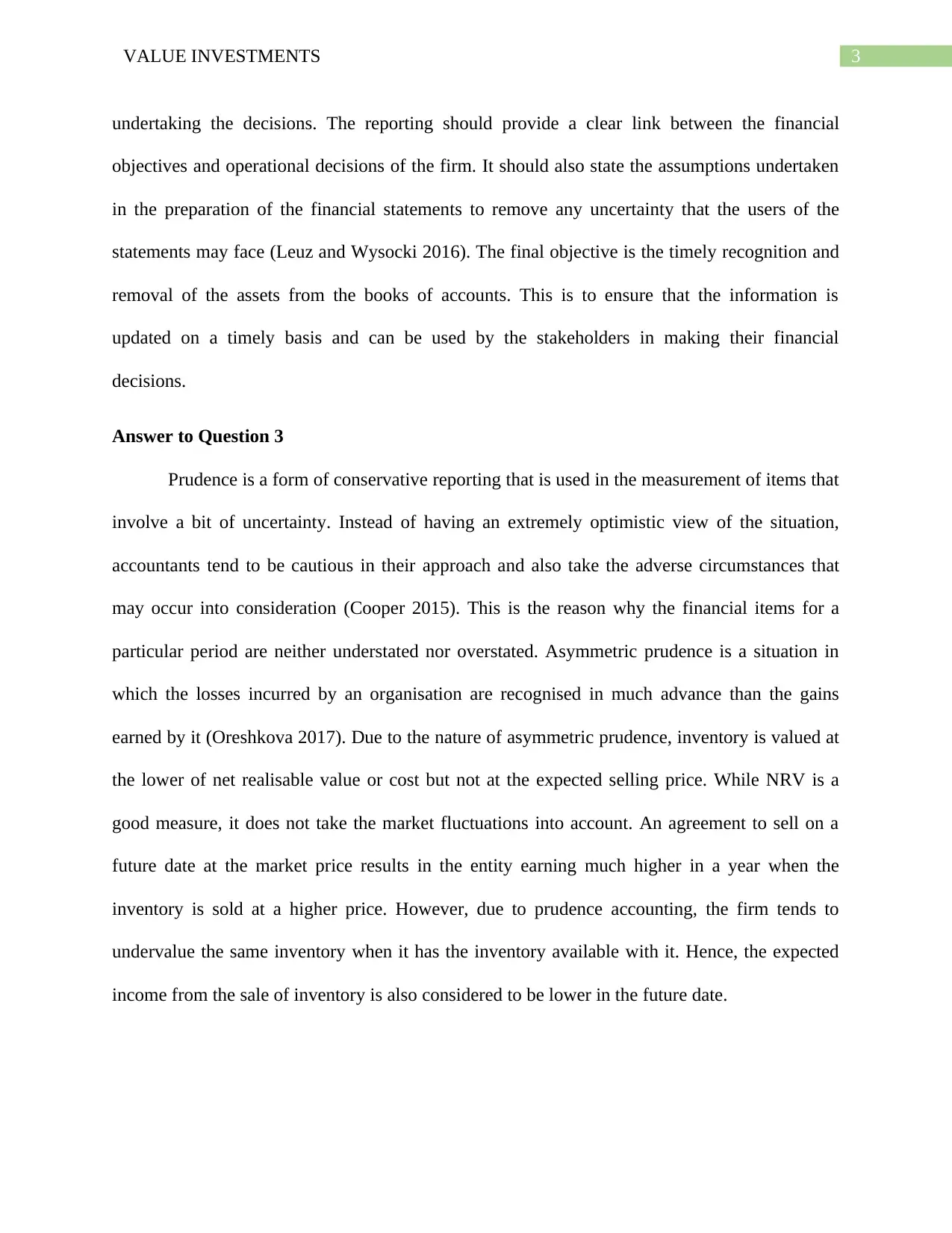
3VALUE INVESTMENTS
undertaking the decisions. The reporting should provide a clear link between the financial
objectives and operational decisions of the firm. It should also state the assumptions undertaken
in the preparation of the financial statements to remove any uncertainty that the users of the
statements may face (Leuz and Wysocki 2016). The final objective is the timely recognition and
removal of the assets from the books of accounts. This is to ensure that the information is
updated on a timely basis and can be used by the stakeholders in making their financial
decisions.
Answer to Question 3
Prudence is a form of conservative reporting that is used in the measurement of items that
involve a bit of uncertainty. Instead of having an extremely optimistic view of the situation,
accountants tend to be cautious in their approach and also take the adverse circumstances that
may occur into consideration (Cooper 2015). This is the reason why the financial items for a
particular period are neither understated nor overstated. Asymmetric prudence is a situation in
which the losses incurred by an organisation are recognised in much advance than the gains
earned by it (Oreshkova 2017). Due to the nature of asymmetric prudence, inventory is valued at
the lower of net realisable value or cost but not at the expected selling price. While NRV is a
good measure, it does not take the market fluctuations into account. An agreement to sell on a
future date at the market price results in the entity earning much higher in a year when the
inventory is sold at a higher price. However, due to prudence accounting, the firm tends to
undervalue the same inventory when it has the inventory available with it. Hence, the expected
income from the sale of inventory is also considered to be lower in the future date.
undertaking the decisions. The reporting should provide a clear link between the financial
objectives and operational decisions of the firm. It should also state the assumptions undertaken
in the preparation of the financial statements to remove any uncertainty that the users of the
statements may face (Leuz and Wysocki 2016). The final objective is the timely recognition and
removal of the assets from the books of accounts. This is to ensure that the information is
updated on a timely basis and can be used by the stakeholders in making their financial
decisions.
Answer to Question 3
Prudence is a form of conservative reporting that is used in the measurement of items that
involve a bit of uncertainty. Instead of having an extremely optimistic view of the situation,
accountants tend to be cautious in their approach and also take the adverse circumstances that
may occur into consideration (Cooper 2015). This is the reason why the financial items for a
particular period are neither understated nor overstated. Asymmetric prudence is a situation in
which the losses incurred by an organisation are recognised in much advance than the gains
earned by it (Oreshkova 2017). Due to the nature of asymmetric prudence, inventory is valued at
the lower of net realisable value or cost but not at the expected selling price. While NRV is a
good measure, it does not take the market fluctuations into account. An agreement to sell on a
future date at the market price results in the entity earning much higher in a year when the
inventory is sold at a higher price. However, due to prudence accounting, the firm tends to
undervalue the same inventory when it has the inventory available with it. Hence, the expected
income from the sale of inventory is also considered to be lower in the future date.
Paraphrase This Document
Need a fresh take? Get an instant paraphrase of this document with our AI Paraphraser
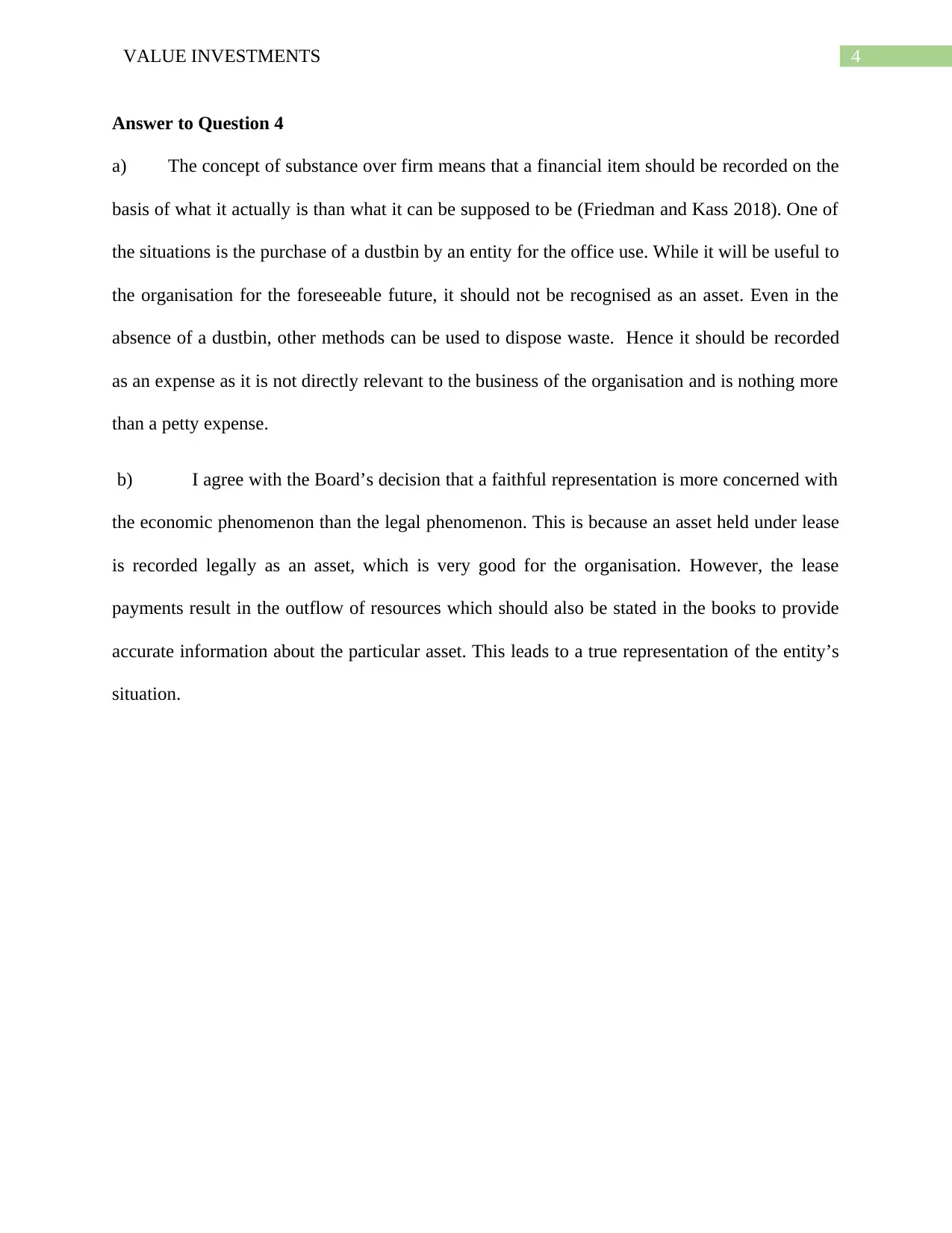
4VALUE INVESTMENTS
Answer to Question 4
a) The concept of substance over firm means that a financial item should be recorded on the
basis of what it actually is than what it can be supposed to be (Friedman and Kass 2018). One of
the situations is the purchase of a dustbin by an entity for the office use. While it will be useful to
the organisation for the foreseeable future, it should not be recognised as an asset. Even in the
absence of a dustbin, other methods can be used to dispose waste. Hence it should be recorded
as an expense as it is not directly relevant to the business of the organisation and is nothing more
than a petty expense.
b) I agree with the Board’s decision that a faithful representation is more concerned with
the economic phenomenon than the legal phenomenon. This is because an asset held under lease
is recorded legally as an asset, which is very good for the organisation. However, the lease
payments result in the outflow of resources which should also be stated in the books to provide
accurate information about the particular asset. This leads to a true representation of the entity’s
situation.
Answer to Question 4
a) The concept of substance over firm means that a financial item should be recorded on the
basis of what it actually is than what it can be supposed to be (Friedman and Kass 2018). One of
the situations is the purchase of a dustbin by an entity for the office use. While it will be useful to
the organisation for the foreseeable future, it should not be recognised as an asset. Even in the
absence of a dustbin, other methods can be used to dispose waste. Hence it should be recorded
as an expense as it is not directly relevant to the business of the organisation and is nothing more
than a petty expense.
b) I agree with the Board’s decision that a faithful representation is more concerned with
the economic phenomenon than the legal phenomenon. This is because an asset held under lease
is recorded legally as an asset, which is very good for the organisation. However, the lease
payments result in the outflow of resources which should also be stated in the books to provide
accurate information about the particular asset. This leads to a true representation of the entity’s
situation.
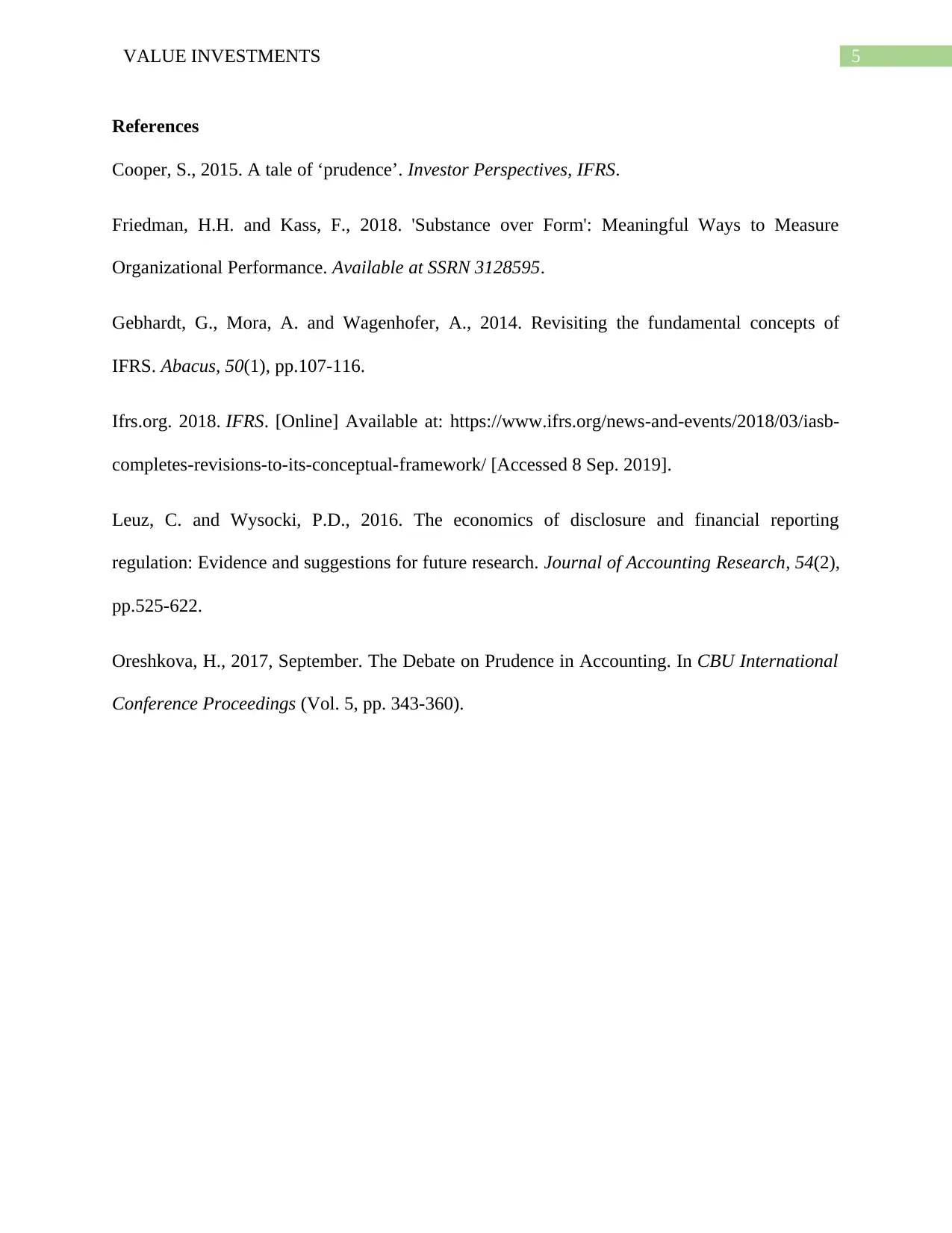
5VALUE INVESTMENTS
References
Cooper, S., 2015. A tale of ‘prudence’. Investor Perspectives, IFRS.
Friedman, H.H. and Kass, F., 2018. 'Substance over Form': Meaningful Ways to Measure
Organizational Performance. Available at SSRN 3128595.
Gebhardt, G., Mora, A. and Wagenhofer, A., 2014. Revisiting the fundamental concepts of
IFRS. Abacus, 50(1), pp.107-116.
Ifrs.org. 2018. IFRS. [Online] Available at: https://www.ifrs.org/news-and-events/2018/03/iasb-
completes-revisions-to-its-conceptual-framework/ [Accessed 8 Sep. 2019].
Leuz, C. and Wysocki, P.D., 2016. The economics of disclosure and financial reporting
regulation: Evidence and suggestions for future research. Journal of Accounting Research, 54(2),
pp.525-622.
Oreshkova, H., 2017, September. The Debate on Prudence in Accounting. In CBU International
Conference Proceedings (Vol. 5, pp. 343-360).
References
Cooper, S., 2015. A tale of ‘prudence’. Investor Perspectives, IFRS.
Friedman, H.H. and Kass, F., 2018. 'Substance over Form': Meaningful Ways to Measure
Organizational Performance. Available at SSRN 3128595.
Gebhardt, G., Mora, A. and Wagenhofer, A., 2014. Revisiting the fundamental concepts of
IFRS. Abacus, 50(1), pp.107-116.
Ifrs.org. 2018. IFRS. [Online] Available at: https://www.ifrs.org/news-and-events/2018/03/iasb-
completes-revisions-to-its-conceptual-framework/ [Accessed 8 Sep. 2019].
Leuz, C. and Wysocki, P.D., 2016. The economics of disclosure and financial reporting
regulation: Evidence and suggestions for future research. Journal of Accounting Research, 54(2),
pp.525-622.
Oreshkova, H., 2017, September. The Debate on Prudence in Accounting. In CBU International
Conference Proceedings (Vol. 5, pp. 343-360).
⊘ This is a preview!⊘
Do you want full access?
Subscribe today to unlock all pages.

Trusted by 1+ million students worldwide
1 out of 6
Related Documents
Your All-in-One AI-Powered Toolkit for Academic Success.
+13062052269
info@desklib.com
Available 24*7 on WhatsApp / Email
![[object Object]](/_next/static/media/star-bottom.7253800d.svg)
Unlock your academic potential
Copyright © 2020–2025 A2Z Services. All Rights Reserved. Developed and managed by ZUCOL.





